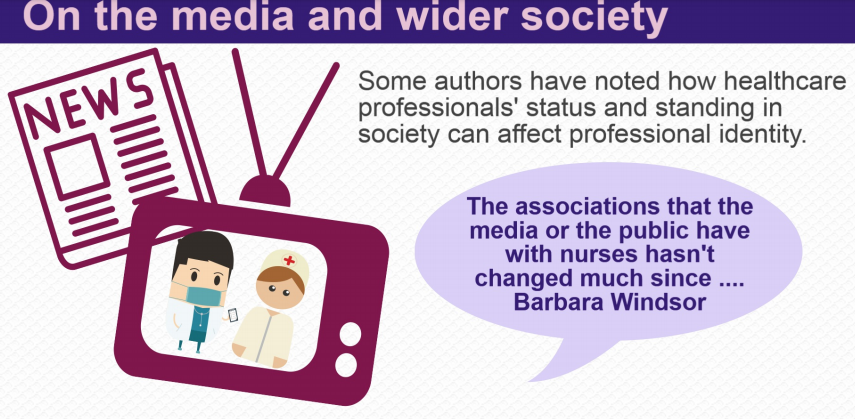by
Daisy Blench, Policy Manager
| Jun 13, 2019
Question: When is a nurse not a nurse?
Answer: When she runs the London marathon dressed in the uniform she wears to work every day, a similar uniform worn by nurses across the UK.
In our latest blog, our Policy Manager, Daisy Blench reflects on a recent talk she gave to nursing associate students at Solent University, and the Authority’s work on professional identity and the factors that influence its formation.

Nurse Jessica Anderson hit the headlines recently during April’s London Marathon when she beat the Guinness world record for being the fastest female marathon runner dressed as a nurse. Later, she was rather put out to discover that, as her scrubs and trousers did not in fact match their (somewhat outdated) uniform criteria, her achievement would not be recognised.
According to the Guiness Book of World Records, a nurse’s outfit should include a blue or white dress, a white pinafore apron and a white nurse’s cap, a description most definitely stuck somewhere in the mid 20th century. This was news to Jessica who, along with the majority of her colleagues (male and female), wears scrubs to work. Jessica was subsequently awarded the record after a backlash and the Guinness Book of World Records have announced that they are reviewing their criteria for what constitutes a nurse’s uniform.
The case raises interesting questions about the different factors affecting professional identity, including the wearing of uniforms and how much identity as a professional is defined by external factors. The media and popular culture have no doubt played a role in creating a fixed image of a nurse which perpetuates and that many still identify with.
What role for regulation in forming professional identity?
We have commissioned research into professional identity, in particular looking at the role that regulation plays in its formation and maintenance. We found that whilst regulators have a part to play in the shaping of identity through their role in the quality assurance of education and training, professional identity is primarily formed and affected by factors closer to professionals. These include interaction with patients and colleagues, everyday tasks and the context in which an individual works.
I recently went to talk to nursing associate apprentices and healthcare assistant practitioners at Solent University in Southampton about professional identity and many of these issues were raised by attendees. A key theme on the day was role confusion and uncertainty with attendees discussing the challenges they faced when nursing, and other, colleagues didn’t understand their role. They also highlighted the impact on professional identity when there is a lack of validation of their role from colleagues within the healthcare team.
Can wearing a uniform help strengthen professional identity?
For some, what they wore was a key issue, with one attendee suggesting that standardised national uniform could help to strengthen identity and help patients differentiate between registered nurses, nursing associates and healthcare assistants. However, nursing associate students working in a mental health setting highlighted that for them, uniform could be a barrier to effective engagement with patients who preferred them to wear ordinary clothing in the workplace.
Regulation as a badge of honour
Whilst regulation was not raised as a key influence on identity, the disparity between those who would ultimately be registered as nursing associates and those who have chosen to continue as unregistered assistant practitioners raised questions of legitimacy for the assistant practitioners who were present. They felt that they were working at the same level as nursing associates, albeit in a more specialised area, and that lack of regulation was seen to raise issues of fairness and imply a lower status or level of experience. This echoed a commonly heard view that regulation is seen as a badge of status and provides legitimacy to the professional.
Despite our findings that regulation generally has only a limited impact on the formation of professional identity, an interesting observation from one attendee was that the nursing associate role may be slightly unique in that it was developed in close cooperation with the Nursing and Midwifery Council following the Government’s decision that the role would be regulated in January 2017.
This raises the question of what impact regulation might have on the formation of the scope and identity of new roles, if decisions about whether a role should be regulated are made partly in response to workforce objectives rather than being based primarily on a need to manage risk to patient safety.
The recently published interim NHS People Plan developed by NHS Improvement stated that: ‘The government’s commitment to regulate physician associates is a significant step towards maximising their capability and embedding this critical role in our workforce.’
If in the future roles are regulated in part due to a desire to develop their potential and meet workforce objectives, does this mean that regulation will come to play a greater part in the formation of professional identity? Furthermore, will this have implications for how the role is subsequently regulated and for the role of the regulator in balancing the interests of patient safety against workforce objectives?
A right-touch approach to regulating risk
The Authority continues to highlight the need for regulation to be used proportionately and for decisions to be based clearly on risk of harm. However, it is clear that the interaction between regulation, professional identity and indeed workforce will continue to develop and the questions this raises will warrant further exploration and discussion.
Related Material
You can find all of our publications on professional identity here. Or watch our short video on the findings of our literature review on professional regulation.